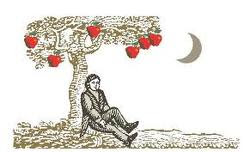History of Gravitation: Science part two
Gravitation is one of the four fundamental interactions of nature, along with the strong force, electromagnetism and the weak force. Modern physics describes gravitation using the general theory of relativity, in which gravitation is a consequence of the curvature of spacetime which governs the motion of inertial objects. The simpler Newton's law of universal gravitation provides an accurate approximation for most calculations.
Scientific revolution
Modern work on gravitational theory began with the work of Galileo Galilei in the late 16th and early 17th centuries. In his famous (though possibly apocryphal) experiment dropping balls from the Tower of Pisa, and later with careful measurements of balls rolling down inclines, Galileo showed that gravitation accelerates all objects at the same rate. This was a major departure from Aristotle's belief that heavier objects accelerate faster. Galileo correctly postulated air resistance as the reason that lighter objects may fall more slowly in an atmosphere. Galileo's work set the stage for the formulation of Newton's theory of gravity.
Scientific revolution

Modern work on gravitational theory began with the work of Galileo Galilei in the late 16th and early 17th centuries. In his famous (though possibly apocryphal) experiment dropping balls from the Tower of Pisa, and later with careful measurements of balls rolling down inclines, Galileo showed that gravitation accelerates all objects at the same rate. This was a major departure from Aristotle's belief that heavier objects accelerate faster. Galileo correctly postulated air resistance as the reason that lighter objects may fall more slowly in an atmosphere. Galileo's work set the stage for the formulation of Newton's theory of gravity.
Newton's theory of gravitationMain article: Newton's law of universal gravitation 
In 1687, English mathematician Sir Isaac Newton published Principia, which hypothesizes the inverse-square law of universal gravitation. In his own words, “I deduced that the forces which keep the planets in their orbs must be reciprocally as the squares of their distances from the centers about which they revolve: and thereby compared the force requisite to keep the Moon in her Orb with the force of gravity at the surface of the Earth; and found them answer pretty nearly.”
Newton's theory enjoyed its greatest success when it was used to predict the existence of Neptune based on motions of Uranus that could not be accounted for by the actions of the other planets. Calculations by both John Couch Adams and Urbain Le Verrier predicted the general position of the planet, and Le Verrier's calculations are what led Johann Gottfried Galle to the discovery of Neptune.
predicted the general position of the planet, and Le Verrier's calculations are what led Johann Gottfried Galle to the discovery of Neptune.
A discrepancy in Mercury's orbit pointed out flaws in Newton's theory. By the end of the 19th century, it was known that its orbit showed slight perturbations that could not be accounted for entirely under Newton's theory, but all searches for another perturbing body (such as a planet orbiting the Sun even closer than Mercury) had been fruitless. The issue was resolved in 1915 by Albert Einstein's new theory of general relativity, which accounted for the small discrepancy in Mercury's orbit.
Although Newton's theory has been superseded, most modern non-relativistic gravitational calculations are still made using Newton's theory because it is a much simpler theory to work with than general relativity, and gives sufficiently accurate results for most applications involving sufficiently small masses, speeds and energies.
with than general relativity, and gives sufficiently accurate results for most applications involving sufficiently small masses, speeds and energies.
Gravitation, or gravity, is a natural phenomenon in which objects with mass attract one another. In everyday life, gravitation is most familiar as the agent that gives weight to objects with mass and causes them to fall to the ground when dropped. Gravitation causes dispersed matter to coalesce, thus accounting for the existence of the Earth, the Sun, and most of the macroscopic objects in the universe. Gravitation is responsible for keeping the Earth and the other planets in their orbits around the Sun; for keeping the Moon in its orbit around the Earth; for the formation of tides; for natural convection, by which fluid flow occurs under the influence of a density gradient and gravity; for heating the interiors of forming stars and planets to very high temperatures; and for various other phenomena observed on Earth.
Gravitation is responsible for keeping the Earth and the other planets in their orbits around the Sun; for keeping the Moon in its orbit around the Earth; for the formation of tides; for natural convection, by which fluid flow occurs under the influence of a density gradient and gravity; for heating the interiors of forming stars and planets to very high temperatures; and for various other phenomena observed on Earth.
Equivalence principle:
The equivalence principle, explored by a succession of researchers including Galileo, Loránd Eötvös, and Einstein, expresses the idea that all objects fall in the same way. The simplest way to test the weak equivalence principle is to drop two objects of different masses or compositions in a vacuum, and see if they hit the ground at the same time. These experiments demonstrate that all objects fall at the same rate when friction (including air resistance) is negligible. More sophisticated tests use a torsion balance of a type invented by Eötvös. Satellite experiments are planned for more accurate experiments in space.
Loránd Eötvös, and Einstein, expresses the idea that all objects fall in the same way. The simplest way to test the weak equivalence principle is to drop two objects of different masses or compositions in a vacuum, and see if they hit the ground at the same time. These experiments demonstrate that all objects fall at the same rate when friction (including air resistance) is negligible. More sophisticated tests use a torsion balance of a type invented by Eötvös. Satellite experiments are planned for more accurate experiments in space.
Formulations of the equivalence principle include:
** The weak equivalence principle: The trajectory of a point mass in a gravitational field depends only on its initial position and velocity, and is independent of its composition.
** The Einsteinian equivalence principle: The outcome of any local non-gravitational experiment in a freely falling laboratory is independent of the velocity of the laboratory and its location in spacetime.

In 1687, English mathematician Sir Isaac Newton published Principia, which hypothesizes the inverse-square law of universal gravitation. In his own words, “I deduced that the forces which keep the planets in their orbs must be reciprocally as the squares of their distances from the centers about which they revolve: and thereby compared the force requisite to keep the Moon in her Orb with the force of gravity at the surface of the Earth; and found them answer pretty nearly.”
Newton's theory enjoyed its greatest success when it was used to predict the existence of Neptune based on motions of Uranus that could not be accounted for by the actions of the other planets. Calculations by both John Couch Adams and Urbain Le Verrier
 predicted the general position of the planet, and Le Verrier's calculations are what led Johann Gottfried Galle to the discovery of Neptune.
predicted the general position of the planet, and Le Verrier's calculations are what led Johann Gottfried Galle to the discovery of Neptune.A discrepancy in Mercury's orbit pointed out flaws in Newton's theory. By the end of the 19th century, it was known that its orbit showed slight perturbations that could not be accounted for entirely under Newton's theory, but all searches for another perturbing body (such as a planet orbiting the Sun even closer than Mercury) had been fruitless. The issue was resolved in 1915 by Albert Einstein's new theory of general relativity, which accounted for the small discrepancy in Mercury's orbit.
Although Newton's theory has been superseded, most modern non-relativistic gravitational calculations are still made using Newton's theory because it is a much simpler theory to work
 with than general relativity, and gives sufficiently accurate results for most applications involving sufficiently small masses, speeds and energies.
with than general relativity, and gives sufficiently accurate results for most applications involving sufficiently small masses, speeds and energies.Gravitation, or gravity, is a natural phenomenon in which objects with mass attract one another. In everyday life, gravitation is most familiar as the agent that gives weight to objects with mass and causes them to fall to the ground when dropped. Gravitation causes dispersed matter to coalesce, thus accounting for the existence of the Earth, the Sun, and most of the macroscopic objects in the universe.
 Gravitation is responsible for keeping the Earth and the other planets in their orbits around the Sun; for keeping the Moon in its orbit around the Earth; for the formation of tides; for natural convection, by which fluid flow occurs under the influence of a density gradient and gravity; for heating the interiors of forming stars and planets to very high temperatures; and for various other phenomena observed on Earth.
Gravitation is responsible for keeping the Earth and the other planets in their orbits around the Sun; for keeping the Moon in its orbit around the Earth; for the formation of tides; for natural convection, by which fluid flow occurs under the influence of a density gradient and gravity; for heating the interiors of forming stars and planets to very high temperatures; and for various other phenomena observed on Earth.Equivalence principle:
The equivalence principle, explored by a succession of researchers including Galileo,
 Loránd Eötvös, and Einstein, expresses the idea that all objects fall in the same way. The simplest way to test the weak equivalence principle is to drop two objects of different masses or compositions in a vacuum, and see if they hit the ground at the same time. These experiments demonstrate that all objects fall at the same rate when friction (including air resistance) is negligible. More sophisticated tests use a torsion balance of a type invented by Eötvös. Satellite experiments are planned for more accurate experiments in space.
Loránd Eötvös, and Einstein, expresses the idea that all objects fall in the same way. The simplest way to test the weak equivalence principle is to drop two objects of different masses or compositions in a vacuum, and see if they hit the ground at the same time. These experiments demonstrate that all objects fall at the same rate when friction (including air resistance) is negligible. More sophisticated tests use a torsion balance of a type invented by Eötvös. Satellite experiments are planned for more accurate experiments in space.Formulations of the equivalence principle include:
** The weak equivalence principle: The trajectory of a point mass in a gravitational field depends only on its initial position and velocity, and is independent of its composition.

** The Einsteinian equivalence principle: The outcome of any local non-gravitational experiment in a freely falling laboratory is independent of the velocity of the laboratory and its location in spacetime.
** The strong equivalence principle requiring both of the above.
The equivalence principle can be used to make physical deductions about the gravitational constant, the geometrical nature of gravity, the possibility of a fifth force, and the validity of concepts such as general relativity and Brans-Dicke theory.
The equivalence principle can be used to make physical deductions about the gravitational constant, the geometrical nature of gravity, the possibility of a fifth force, and the validity of concepts such as general relativity and Brans-Dicke theory.



Comments
Post a Comment